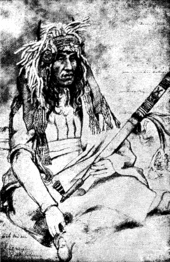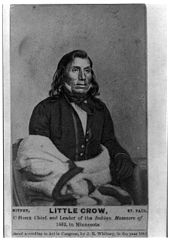- Little Crow
-
This article is about the Dakota chief. For the bird, see Little Crow (bird)
Little Crow 
Taoyateduta, known as Little CrowBorn ca. 1810
Kaposia (now in South St. Paul, Minnesota)Died July 3, 1863
MinnesotaKnown for Chief of the Mdewakanton Dakota or Sioux Spouse twenty wives Children thirty-six children Little Crow (Sioux: Thaóyate Dúta; ca. 1810–July 3, 1863) was a chief of the Mdewakanton Dakota Sioux. His given name translates as "His Red Nation," (Thaóyate Dúta) but he was known as Little Crow because of his father's name, Čhetáŋ Wakhúwa Máni, (literally, "Hawk that chases/hunts walking") which was mistranslated.
Little Crow is notable in for his role in the negotiation of the Treaties of Traverse des Sioux and Mendota of 1851, in which he agreed to the movement of his band of the Dakota to a reservation near the Minnesota River in exchange for goods and certain other rights. However, the government reneged on its promises to provide food and annuities to the tribe, and Little Crow was forced to support the decision of a Dakota war council in 1862 to pursue war to drive out the whites from Minnesota. Little Crow participated in the Dakota War of 1862, but retreated in September 1862 before the war's conclusion in December 1862. Little Crow was killed on July 3, 1863 by a settler who wished to collect the bounty given to any person who killed a Dakota in Minnesota.
Contents
Early life
 Little Crow at Traverse des Sioux 1851
Little Crow at Traverse des Sioux 1851
Little Crow was born at the Dakota settlement of Kaposia, near what is modern-day South St. Paul, Minnesota. His father died in 1846 after accidentally discharging a gun. Tribal leadership was disputed between Little Crow and his brother, which resulted in an armed fight that saw Little Crow shot in the wrist, leaving permanent scars that he concealed with long sleeves for the rest of his life. By 1849, however, Little Crow was able to take control of the tribe.
In 1851, the United States negotiated the Treaty of Traverse des Sioux and the Treaty of Mendota with the Dakota people. Little Crow was present at Traverse des Sioux and signed the Mendota treaty,[1] by which the tribes agreed to move to land set aside along the Minnesota River to the west.[2] The treaty as ratified by the United States Senate removed Article 3 of the treaty, which had set aside this land.[2] The tribe was compelled to negotiate a new treaty, under threat of forcible removal to the Dakota Territory, and was only granted land on one side of the river.
Little Crow tried to get along with the customs of the United States.[3] He visited President James Buchanan in Washington, D.C., replaced his native clothing with trousers and jackets with brass buttons, joined the Episcopal Church, and took up farming. However, by 1862, stress built up in his community as cheating by traders came to light and Congress failed to pay the annuities mandated by treaty in exchange for the land. As the tribe grew hungry and as food languished in the warehouses of the traders, Little Crow's ability to restrain his people deteriorated.
Dakota War of 1862
Main article: Dakota War of 1862On August 4, 1862, about five hundred Dakota broke into the food warehouses at the Lower Agency. The agent in charge, Thomas J. Galbraith, ordered defending troops not to shoot and called for a council. At the conference, Little Crow pointed out that the Dakota were owed the money to buy the food and warned that "When men are hungry, they help themselves." The representative of the traders, Andrew Myrick, replied, "So far as I am concerned, if they are hungry let them eat grass or their own dung." Within weeks, on August 17, 1862, a band of Dakota crossed paths with a group of white civilian settlers. The Dakota killed 5 of the white civilians and mutilated their bodies.
The tribe's need for food and hatred for the white settlers led to the Dakota War of 1862. Little Crow agreed to lead the tribes through the conflict, even though he knew they were outnumbered and out-gunned. The Dakota first attacked Andrew Myrick's house; they killed him and stuffed his mouth with grass in revenge for his words. Under Taoyateduda's leadership the Dakota initially won battles the US Army such as the attack and burning of New Ulm, Minnesota, whilst attacking white civilians along the way.[4] In spite of these victories, Little Crow's forces suffered a rout at the Battle of Wood Lake on September 23, 1862, and Little Crow was forced to flee to Canada.
Death
Deciding that the tribe must adopt a mobile existence, having been robbed of its territory, he returned to steal horses from his former land in Minnesota. On July 3 1863, while he and his son Wowinapa were foraging for berries in a farmer's field, they were spotted by the landowner Nathan Lamson and his son. The four engaged in a brief firefight in which Little Crow fired twice, once wounding the elder Lamson. Lamson and his son both shot and mortally wounded Little Crow. The chief then told his son to flee. Lamson's son then ran for nearly 12 miles to Hutchinson, Minnesota to gather a search-and-recovery party. The townspeople quickly departed to find a wounded Lamson and a dead and unidentified Dakota man. When they discovered the latter was Little Crow, they mutilated and displayed the body.
Nathan Lamson received a standard bounty for the scalp of a Dakota, plus an addition $500 bounty when it was discovered the remains were that of Little Crow. Little Crow's body was transported back to Hutchinson where it was again mutilated by the citizens. His body was dragged down the town's Main Street while firecrackers were placed in his ears and dogs picked at his head. After their celebration, the town disposed of the body in an alley, where ordinary garbage was regularly thrown. The Minnesota Historical Society received his scalp in 1868, and his skull in 1896. Other bones were collected at other times. In 1971, Little Crow's remains were returned to his grandson Jesse Wakeman (son of Wowinapa) for burial. A small stone tablet sits at the roadside of the field where Little Crow was killed.
 Sculpture of Little Crow at Minneapolis
Sculpture of Little Crow at Minneapolis
Legacy
In 1937, the city of Hutchinson erected a large bronze statue of Little Crow in a spot overlooking the Crow River near the Main Street bridge access to the downtown business district. In 1982, the artist of the original statue, Les Kouba, created an updated statue; the original statue is now at the McLeod County Historical Society and the new statue still overlooks the Crow River.[5]
A mask commemorating Little Crow is near the waterfall in Minnehaha Park in Minneapolis.[6]
The American historian Gary Clayton Anderson has written Little Crow: Spokesman for the Sioux, published in 1986 by the Minnesota Historical Society.[7]A contributor to New Mexico Historical Review calls Anderson's book a "major contribution to our understanding of an Indian tribe that profoundly influenced the course of history in the upper Mississippi Valley, partly at least through the personal role played by its most famous leader."[8]Anderson has also written on Sitting Bull.[9]
References
- ^ Mayer (1986), pp. 149, 202, 242.
- ^ a b "Treaty with the Sioux — Mdewakanton and Wahpakoota Bands, 1851". Indian Affairs: Laws and Treaties. Government Printing Office. http://digital.library.okstate.edu/kappler/Vol2/treaties/sio0591.htm. Retrieved 2008-03-22.
- ^ Brown, Dee (1970) Bury My Heart at Wounded Knee, ISBN 0-330-23219-3, chapter 2: "Little Crow's War"
- ^ Burnham, Frederick Russell (1926). Scouting on Two Continents. New York: Doubleday, Page and Co. p. 2 (autobiographical account). ASIN B000F1UKOA.
- ^ "Little Crow statue". McCleod County Historical Society. Archived from the original on 2007-12-18. http://web.archive.org/web/20071218031146/http://www.mcleodhistory.org/kouba/largeimages/riverstatue.htm. Retrieved 2008-03-22.
- ^ "Minnehaha Park". Minneapolis Park and Recreation Board. http://www.minneapolisparks.org/default.asp?PageID=4&parkid=252. Retrieved February 4, 2010.
- ^ Little Crow: Spokesman for the Sioux. St. Paul, Minnesota: Minnesota Historical Society, 1986, ISBN 0-87351-196-4. http://www.mnhs.org/library/tips/history_topics/94dakota.html. Retrieved October 23, 2010.
- ^ "Little Crow: Spokesman for the Sioux". mnhs.org. http://shop.mnhs.org/moreinfo.cfm?Product_ID=209. Retrieved October 23, 2010.
- ^ Sitting Bull and the Paradox of Lakota Nationhood. Prentice Hall, ISBN: 9780321421920. http://www.indiaplaza.in/sitting-bull-paradox-of-lakota-nationhood-anderson-gary-clayton/books/9780321421920.htm. Retrieved October 23, 2010.
http://www.hutchinsonleader.com/editorial-wheres-little-crow-105
The original statue of Little Crow was replaced by one done by sculptor Robert Johnson in 1982-3, working in collaboration with Les Kouba.
Sources
- Anderson, Gary Clayton (1986) Little Crow, spokesman for the Sioux. Saint Paul: Minnesota Historical Society Press.
- Carley, Kenneth (2001) The Dakota War of 1862. Saint Paul: Minnesota Historical Society Press.
- Clodfelter, Michael (1998) The Dakota War: The United States Army Versus the Sioux, 1862-1865. Jefferson, N.C.: McFarland.
- Mayer, Frank Blackwell (1986) With Pen and Pencil on the Frontier in 1851. Saint Paul: Minnesota Historical Society Press. ISBN 0-87351-195-6.
- Nix, Jacob (1994) The Sioux Uprising in Minnesota, 1862: Jacob Nix's Eyewitness History. Gretchen Steinhauser, Don Heinrich Tolzmann & Eberhard Reichmann, trans. Don Heinrich Tolzmann, ed. Indianapolis: Max Kade German-American Center, Indiana University-Purdue University at Indianapolis and Indiana German Heritage Society, Inc.
- Schultz, Duane (1992) Over the Earth I Come: The Great Sioux Uprising of 1862. New York: St. Martin's Press.
- Swain, Gwenyth (2004) Little Crow: Leader of the Dakota. Saint Paul, MN, Borealis Books.
- Tolzmann, Don Heinrich, ed. (2002) German pioneer accounts of the great Sioux Uprising of 1862. Milford, Ohio: Little Miami Pub. Co.
External links
- "Little Crow". Encyclopedia of North American Indians. http://college.hmco.com/history/readerscomp/naind/html/na_020000_littlecrow.htm. Retrieved 2005-05-20.
- Little Crow Trail
- Minnesota Historical Society History Topics: Dakota War of 1862
- Documetary on Little Crow on Google Video
- Dakota Blues - The history of The Great Sioux Nation
 Gen. Henry H. Sibley (1892). "Little Crow". Appletons' Cyclopædia of American Biography.
Gen. Henry H. Sibley (1892). "Little Crow". Appletons' Cyclopædia of American Biography.
Categories:- 1810s births
- 1863 deaths
- 1863 crimes
- Native American leaders
- Murdered Native American people
- People from Dakota County, Minnesota
- Sioux people
- Dakota War of 1862
- People murdered in Minnesota
- Deaths by firearm in Minnesota
- Year of birth uncertain
Wikimedia Foundation. 2010.


